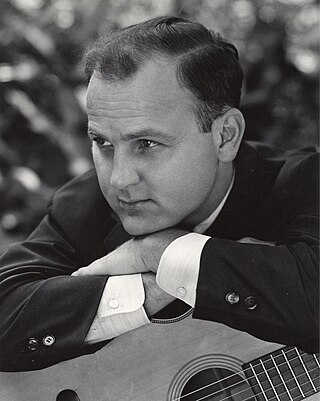
Ernest Loring "Red" Nichols was an American jazz cornetist, composer, and jazz bandleader.

Henry James "Red" Allen, Jr. was an American jazz trumpeter and vocalist whose playing has been claimed by Joachim-Ernst Berendt and others as the first to fully incorporate the innovations of Louis Armstrong.

Albert Edwin Condon was an American jazz banjoist, guitarist, and bandleader. A leading figure in Chicago jazz, he also played piano and sang.

Glenn Gray Knoblauch, known professionally as Glen Gray, was an American jazz saxophonist and leader of the Casa Loma Orchestra.

Walter Gerhardt "Pee Wee" Hunt was an American jazz trombonist, vocalist, and bandleader. Hunt was born in Mount Healthy, Ohio. He developed a musical interest at an early age, as his mother, Sadie, played the banjo and his father, Edgar C., played violin. He had a younger sister, Marian, and younger brother, Raymond. The teenage Hunt was a banjoist with a local band while he was attending college at Ohio State University, where he majored in Electrical Engineering, and during his college years he switched from banjo to trombone. He graduated from the Cincinnati Conservatory of Music. He joined Jean Goldkette's Orchestra in 1928.

Jack Wilton Marshall was an American jazz guitarist, composer, arranger, and record producer. He was married to Eva Katherine Pellegrini, and the father to four children, three sons, producer/director Frank Marshall, composer Phil Marshall, Matt Marshall, and a daughter, Sally Marshall. Jack is also the cousin of classical guitarist Christopher Parkening.

Elmer "Sonny" Dunham was an American trumpet player and bandleader. A versatile musician, he was one of the few trumpet players who could double on the trombone with equal skill.
Murray McEachern was a Canadian jazz trombonist and alto saxophonist, perhaps best known for having played trombone for Benny Goodman from 1936 to 1937. McEachern is also remembered for playing both the trombone and alto saxophone for the Casa Loma Orchestra from 1937 to 1941.

"Twelfth Street Rag" is a ragtime musical composition published by Euday L. Bowman in 1914.
Clarence Francis Cherock known professionally as Shorty Sherock was an American swing jazz trumpeter.

Nick Fatool was an American jazz drummer.
Steve Philip Jordan was an American jazz guitarist.
Cliff Leeman was an American jazz drummer. His nickname was "Mr. Time".

"Riverboat Shuffle" is a popular song composed by Hoagy Carmichael, Irving Mills, and Dick Voynow. Lyrics were later added by Carmichael and Mitchell Parish.
Uan Rasey was an American musician, best known for his studio work as a trumpet player.
Larry Wagner was an American arranger, composer, and bandleader. He worked for the band of Paul Whiteman and was long associated with Glen Gray and the Casa Loma Orchestra. His compositions "Whistler's Mother-in-Law", "No Name Jive" and "Turn Back the Hands of Time" became nationally popular.

Eugenie Baird was an American big-band, jazz, and radio singer.

Harry Roy Gozzard was an American jazz trumpeter. He performed with Sam Donahue. Other members of Donahue’s band included the former The Tonight Show Starring Johnny Carson bandleader Doc Severinsen, 1946 Esquire Award winner for Best New Female Vocalist Frances Wayne, Grammy Award-winning vocalist and actress Jo Stafford and popular music arranger Leo Reisman. Gozzard and the Donahue band performed a few times with legendary piano-playing bandleader Count Basie. Basie was featured on four Donahue Okeh recordings made in New York on December 26, 1940.
Karl Kiffe was an American jazz drummer featured in specialty numbers in a number of Hollywood feature films during World War II and later as a featured member of Jimmy Dorsey's orchestra.
Anita Blanch Boyer Dukoff, known as Anita Boyer was an American singer of the Big Band Era, described by Billboard as "one of the music business's most proficient canaries". She was noted for performances with Tommy Dorsey (1939), Leo Reisman (1940–41), Artie Shaw (1940), Nat King Cole (1941–44), Jerry Wald (1942–43) and Hoagy Carmichael (1945). With Dorsey she helped popularize the song "I Concentrate On You", and with Reisman she recorded the song "Bewitched, Bothered and Bewildered" for Pal Joey.












